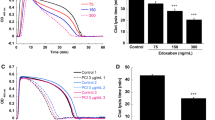Abstract
Thrombin-activatable fibrinolysis inhibitor (TAFI) is a plasma carboxypeptidase that renders a fibrin-containing thrombus less sensitive to lysis. Since the role of TAFI in thrombus formation is still controversial in mice, our present study was designed to evaluate mice deficient in TAFI (TAFI−/−) on FeCl3-induced vena cava and carotid artery thrombosis. Parallel studies were carried out in wild-type mice using a potato carboxypeptidase inhibitor (PCI), a selective inhibitor of activated TAFI (TAFIa). Significant reduction in thrombus formation was observed in TAFI−/− mice (n = 8, P < 0.05 compared to wild-type littermates) but not in heterozygous (TAFI+/−) mice in 3.5% FeCl3-induced vena cava thrombosis. A similar effect was observed following treatment with 5 mg/kg bolus plus 5 mg/kg/h PCI in the same venous thrombosis model in C57BL/6 mice (n = 8, P < 0.01 compared to vehicle). No compositional difference was observed for the venous thrombi in TAFI−/− and wild-type littermates with or without PCI treatment using histological assessment. In contrast, neither TAFI deficiency nor treatment with PCI showed antithrombotic efficacy in the 3.5% FeCl3-induced carotid artery thrombosis model. In a tail transection bleeding time model, both TAFI deficiency and PCI treatment increased bleeding time up to 4.5 and 3.5 times, respectively, over controls (P < 0.05, n = 8). Similar ex vivo fibrinolytic activities were demonstrated for both TAFI deficiency and PCI treatment as enhanced lysis of thrombin-induced plasma clots and lysis of whole blood clot in a thrombelastograph. These data provide direct evidence for the role of TAFIa in vena cava thrombosis without the addition of exogenous thrombolytic in mice. The strong ex vivo fibrinolytic activity of TAFI deficiency or TAFIa inhibition by PCI provides a biomarker of TAFIa inhibition that tracks in vivo antithrombotic efficacy.






Similar content being viewed by others
References
Bouma BN, Meijers JC (2003) Thrombin-activatable fibrinolysis inhibitor (TAFI, plasma procarboxypeptidase B, procarboxypeptidase R, procarboxypeptidase U). J Thromb Haemost 1:1566–1574
Marx PF (2004) Thrombin-activatable fibrinolysis inhibitor. Curr Med Chem 11:2335–2348
Mosnier LO, von dem Borne PA, Meijers JC, Bouma BN (1998) Plasma TAFI levels influence the clot lysis time in healthy individuals in the presence of an intact intrinsic pathway of coagulation. Thromb Haemost 80:829–835
van Tilburg NH, Rosendaal FR, Bertina RM (2000) Thrombin activatable fibrinolysis inhibitor and the risk for deep vein thrombosis. Blood 95:2855–2859
Schroeder V, Chatterjee T, Mehta H, et al (2002) Thrombin activatable fibrinolysis inhibitor (TAFI) levels in patients with coronary artery disease investigated by angiography. Thromb Haemost 88:1020–1025
Zorio E, Castello R, Falco C, Espana F, et al (2003) Thrombin-activatable fibrinolysis inhibitor in young patients with myocardial infarction and its relationship with the fibrinolytic function and the protein C system. Br J Haematol 122:958–965
Montaner J, Ribo M, Monasterio J, Molina CA, Alvarez-Sabin J (2003) Thrombin-activable fibrinolysis inhibitor levels in the acute phase of ischemic stroke. Stroke 34:1038–1040
Redlitz A, Tan AK, Eaton DL, Plow EF (1995) Plasma carboxypeptidases as regulators of the plasminogen system. J Clin Invest 96:2534–2538
Ryan CA, Hass GM, Kuhn RW (1974) Purification and properties of a carboxypeptidase inhibitor from potatoes. J Biol Chem 249:5495–5499
Minnema MC, Friederich PW, Levi M, et al (1998) Enhancement of rabbit jugular vein thrombolysis by neutralization of factor XI. In vivo evidence for a role of factor XI as an anti-fibrinolytic factor. J Clin Invest 101:10–14
Muto Y, Suzuki K, Sato E, Ishii H (2003) Carboxypeptidase B inhibitors reduce tissue factor-induced renal microthrombi in rats. Eur J Pharmacol 461:181–189
Suzuki K, Muto Y, Fushihara K, et al (2004) Enhancement of fibrinolysis by EF6265 [(S)-7-amino-2-[[[(R)-2-methyl-1-(3-phenylpropanoylamino)propyl]hydroxyphosphinoyl] methyl]heptanoic acid], a specific inhibitor of plasma carboxypeptidase B. J Pharmacol Exp Ther 309:607–615
Barrow JC, Nantermet PG, Stauffer SR, et al (2003) Synthesis and evaluation of imidazole acetic acid inhibitors of activated thrombin-activatable fibrinolysis inhibitor as novel antithrombotics. J Med Chem 46:5294–5297
Nagashima M, Yin ZF, Zhao L, et al (2002) Thrombin-activatable fibrinolysis inhibitor (TAFI) deficiency is compatible with murine life. J Clin Invest 109:101–110
Wang X, Smith PL, Hsu M-Y, Ogletree ML, Schumacher WA (2006) Murine model of ferric chloride-induced vena cava thrombosis: evidence for effect of potato carboxypeptidase inhibitor. J Thromb Haemost 4:403–410
Swaisgood CM, Schmitt D, Eaton D, Plow EF (2002) In vivo regulation of plasminogen function by plasma carboxypeptidase B. J Clin Invest 110:1275–1282
Mao SS, Holahan MA, Bailey C, et al (2005) Demonstration of enhanced endogenous fibrinolysis in thrombin activatable fibrinolysis inhibitor-deficient mice. Blood Coagul Fibrinolysis 16:407–415
Wang X, Cheng Q, Xu L, et al (2005) Effects of factor IX or factor XI deficiency on ferric chloride-induced carotid artery occlusion in mice. J Thromb Haemost 3:695–702
von dem Borne PA, Meijers JC, Bouma BN (1995) Feedback activation of factor XI by thrombin in plasma results in additional formation of thrombin that protects fibrin clots from fibrinolysis. Blood 86:3035–3042
Wang X, Hsu M-Y, Steinbacher TE, Monticello TM, Schumacher WA (2006) Quantification of platelet composition in experimental venous thrombosis by real-time polymerase chain reaction. Thromb Res (in press)
Mosnier LO, Meijers JC, Bouma BN (2001) Regulation of fibrinolysis in plasma by TAFI and protein C is dependent on the concentration of thrombomodulin. Thromb Haemost 85:5–11
Bajzar L (2000) Thrombin activatable fibrinolysis inhibitor and an antifibrinolytic pathway. Arterioscler Thromb Vasc Biol 20:2511–2518
Bajzar L, Morser J, Nesheim M (1996) TAFI, or plasma procarboxypeptidase B, couples the coagulation and fibrinolytic cascades through the thrombin–thrombomodulin complex. J Biol Chem 271:16603–16608
Klement P, Liao P, Bajzar L (1999) A novel approach to arterial thrombolysis. Blood 94:2735–2743
Author information
Authors and Affiliations
Corresponding author
Rights and permissions
About this article
Cite this article
Wang, X., Smith, P.L., Hsu, MY. et al. Deficiency in thrombin-activatable fibrinolysis inhibitor (TAFI) protected mice from ferric chloride-induced vena cava thrombosis. J Thromb Thrombolysis 23, 41–49 (2007). https://doi.org/10.1007/s11239-006-9009-4
Published:
Issue Date:
DOI: https://doi.org/10.1007/s11239-006-9009-4




